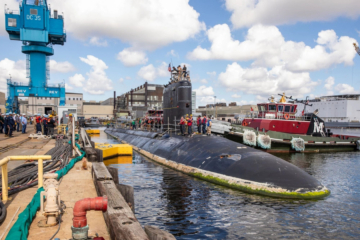LiDAR project maps world’s largest earthen enclosure
Monuments in America take many forms – faces carved in a mountain, bronze statues overlooking a harbor – but in Southwest Nigeria, one monument spanning centuries is at the center of the largest collection of LiDAR data in history.
Sungbo’s Eredo in Nigeria is a system of walls and ditches that is considered the largest earthen enclosure in the world. Using LiDAR, or “light detection and ranging” technology, a team of researchers from William & Mary just completed its work to measure the monument, collecting data over a five-year period.
Led by William & Mary Associate History Professor Gérard Chouin, the LiDAR project was the result of interdisciplinary work across the university, involving the history and anthropology departments and the Center for Geospatial Analysis.
“We have a state of conservation of the monument that can be used in the decades to come to measure and assess progress (and) destruction of the monument,” Chouin said.
According to Chouin, the scale of the project dwarfs all other projects in heritage studies conducted in Africa. One thousand square kilometers of data were collected, 30 times the total area of land previously documented with LiDAR, a system of measurement that uses light in the form of pulsed lasers to map out three-dimensional spaces.
In all, the monument has a total length estimated around 170 kilometers.
“William & Mary very much encourages cross-disciplinary research,” said Neil Norman, associate professor of anthropology. “Collaboration has allowed for Nigerian students, undergraduate and graduate students to be a part of the research progress in many different ways.”
Data is one of the core initiatives of W&M’s Vision 2026 strategic plan, which seeks to integrate computational thinking and data fluency across all fields of research.







Foundations of the eredo
The name Sungbo’s Eredo contains its own history. Eredo is the Yoruba word for a ditch or a bank, and Sungbo comes from the name of the woman who is said to have used her immense wealth to fund labor for the ditch.
The eredo is not merely a piece of land, but provides various functions for the communities it surrounds. As Chouin explained, as a result of the city-state Ijebu that was created in the late 14th century and existed until the 19th century, a trench system was created within the ditch as a line of defense. What at first look like walls are actually build-ups of dirt from the banks.
Additionally, the eredo is theorized to have been created as an act of prestige, with its vastness and depth a boast of the capacity to accumulate people for extreme labor.
“The idea would be that the political power of the architect was basically proving through that monument that they had access to labor,” Chouin said. “It was rich in people.”
“In the West, we have a notion that all monuments need to go up. In West Africa, a lot of the architectural monuments protrude into the ground.”
Neil Norman, Associate Professor of Anthropology
Measurements of the entire eredo were completed in 1998 by archaeologist Patrick Darling, mapping previously unknown areas that had been covered by centuries of forest overgrowth. With better technology and grant funding, Chouin was able to expand on Darling’s findings, presenting an update in August on the completion of the data collection at the Ife Sungbo Archaeological Project Workshop at Augustine University, Ilara, Lagos State, with about 200 participants representing various stakeholders from different branches of government and local communities. Several Nigerian universities and state agencies were involved in the project.

“(This research) not only brings Africa into conversation with other high-profile sites, it’s using industry-standard technology,” Norman said. “That’s a way to promote equity in terms of the way sites are dealt with.”
‘The Nigeria Computer’
Associate Director of Geospatial Analysis Shannon White calls it “The Nigeria Computer.” Tucked in the corner of the Center for Geospatial Analysis, an unassuming dual-monitor computer houses more than a terabyte of data collected by geospatial consulting firm Woolpert, mapping out the eredo at a scale never before seen.
White said the entire map of the eredo is made up of 1,772 titles of data. It’s a number so overwhelming, the computer can only process four tiles at a time in the detail the project requires. That lays the groundwork for analysis ahead: Plotting the length of the monument, tile by tile.
“There’s not a lot of published research that includes the technical how-to,” White said. “You don’t know actually what the back end looks like, because no one talked about it.”
With data collection complete, analysis is now the core of the project. It took five years to gather the data mapping out the eredo. Chouin and White predict the actual processing could take even longer, at least a decade.
Agreement analysis is a critical first step in crunching gathered data. Here, White and student research assistant Ananya Bagai ‘24 compare findings between both Chouin and Darling, confirming where measurements of the eredo align or are inaccurate. So far, White says the eredo is larger than both Darling and Chouin predicted.
A variety of measurement layers allow for extreme accuracy. Processed in Pointcloud, a digital elevation model was created for the entire area, even extending past the measurements of the eredo, to create a bare surface absent of trees and other protruding objects.
“(We) have to look at it from the perspective of what is known versus what to find,” White said.


In doing her analysis, Bagai argued that using an AI model to automate the data would expedite the process. But almost immediately, it was clear that this method would prove difficult, mainly due to how the ditch was created. Just as Chouin had found in his research, the process of digging the eredo wasn’t consistent across the entire boundary, leaving some areas with higher piles than others. This sort of variability makes it difficult for an algorithm to collect the information accurately.
Once data analysis is completed, what is done with official findings remains an open question. Since the project is done on Nigerian soil, the country and local community get to decide what to do, if anything, with the facts presented. Some possibilities include further conservation of the eredo, or plans to increase ecotourism. The eredo covers such a large swath of land, different areas may have different solutions.
“It’s not just simply a historic space; it’s also in some spaces cultural and religious,” White said.
With this project being the largest LiDAR dataset ever collected in African history, the efforts made by William & Mary faculty and students in partnership with universities and government officials in Nigeria could have profound implications for years to come.
“We really are at the cutting edge of technology,” Chouin said.
Latest W&M News
- William & Mary to be the US academic home of submarine productionWilliam & Mary will soon host one of just three centers in the world to support submarine production through the Australia, United Kingdom and United States (AUKUS) security alliance.
- Kerry upholds science, research-backed truth as inaugural Blue Horizons FellowThe new program brings leaders, innovators to William & Mary’s Batten School & VIMS to inspire, engage and collaborate.
- National TRAP Program targets ghostly issue with second round of coastal clean up fundingThe second round of programmatic funding awarded by William & Mary’s Batten School & VIMS totals $1.8M in support of 13 projects focused on removing derelict fishing gear from coastal waters.
- Wiley makes her voice heard — through audiobooksStudents who pursue theatre degrees may find a foothold in a field that's booming: audiobook narration.
- W&M’s cross-university environmental initiative hosts inaugural conferenceThe Virginia Coastal Resilience Collaborative brought together prominent perspectives on important state and local issues.
- On the prowl for owlsWilliam & Mary researchers investigate how the barred owl is adapting to urbanization.











